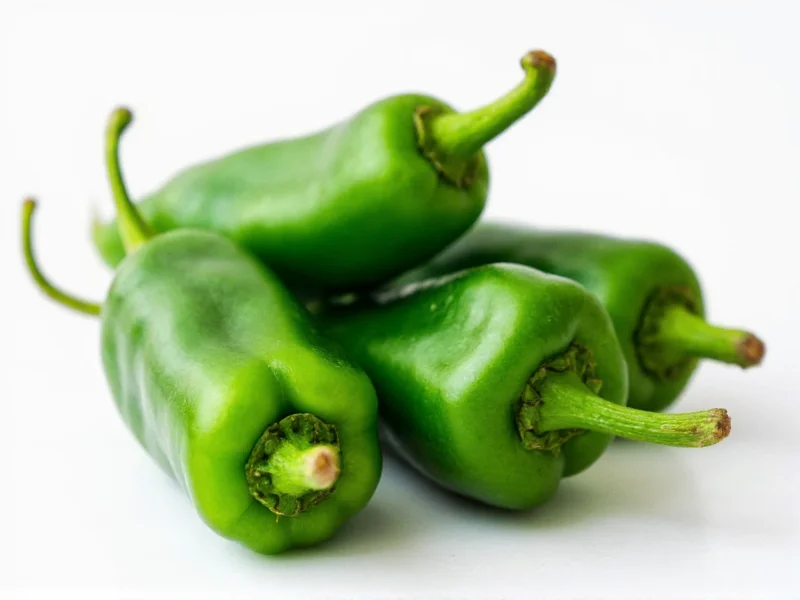Understanding the exact heat level of serrano peppers helps home cooks and culinary professionals create balanced dishes with predictable spice. Unlike inconsistent jalapeños that vary dramatically in heat, serranos maintain a more reliable medium-hot profile that delivers vibrant flavor alongside their signature burn.
Decoding the Scoville Scale for Serrano Peppers
The Scoville scale measures chili pepper pungency by determining capsaicin concentration—the compound responsible for heat. Developed by pharmacist Wilbur Scoville in 1912, this measurement system remains the standard for comparing pepper heat levels today. Serrano peppers consistently register between 10,000 and 23,000 Scoville units, though specific growing conditions can cause minor variations.
Several factors influence where individual serrano peppers fall within this range:
- Color maturity: Green serranos (less mature) tend toward the lower end (10,000-15,000 SHU), while red, orange, or yellow varieties (fully mature) often reach 18,000-23,000 SHU
- Climate conditions: Stress from drought or temperature extremes increases capsaicin production
- Cultivation methods: Soil composition and watering practices affect heat levels
- Genetic variation: Different serrano cultivars naturally produce varying capsaicin levels
Serrano Pepper Characteristics and Identification
Serrano peppers (Capsicum annuum) grow 1-4 inches long with a distinctive tapered shape and thick walls. They typically mature from green to vibrant red, though orange and yellow varieties also exist. Unlike smoother-skinned jalapeños, serranos feature characteristic vertical striations that become more pronounced as they ripen.
| Pepper Characteristic | Serrano Pepper | Jalapeño Pepper |
|---|---|---|
| Scoville Heat Units | 10,000-23,000 SHU | 2,500-8,000 SHU |
| Size | 1-4 inches long | 2-3.5 inches long |
| Shape | Tapered, pointy tip | Thick-walled, blunt tip |
| Texture | Vertical striations | Smooth skin |
| Flavor Profile | Grassy, bright, herbal | Earthy, vegetal, smoky |
Comparing Serrano Heat to Other Popular Peppers
Understanding where serranos fall on the heat spectrum helps predict their culinary impact. This comparison shows how serrano peppers relate to other common chili varieties:
| Pepper Variety | Scoville Range | Heat Relative to Serrano |
|---|---|---|
| Bell Pepper | 0 SHU | 0.0% as hot |
| Jalapeño | 2,500-8,000 SHU | 35-80% as hot |
| Serrano | 10,000-23,000 SHU | 100% |
| Cayenne | 30,000-50,000 SHU | 130-200% as hot |
| Habanero | 100,000-350,000 SHU | 435-1,500% as hot |
Many home cooks mistakenly believe serranos and jalapeños offer similar heat, but serranos typically deliver 2-3 times more capsaicin. This significant difference explains why substituting serranos for jalapeños in recipes often results in unexpectedly spicy dishes.
Culinary Applications of Serrano Peppers
Serrano peppers' balanced heat-to-flavor ratio makes them exceptionally versatile in cooking. Their grassy, bright flavor profile shines in both raw and cooked applications:
- Raw preparations: Finely diced serranos add vibrant heat to pico de gallo, fresh salsas, and guacamole without overwhelming other ingredients
- Cooked dishes: Serranos maintain their flavor integrity when roasted, grilled, or simmered in sauces and stews
- Pickling: Their thick walls hold up well to vinegar-based pickling solutions, creating versatile condiments
- Infusions: Serranos impart clean heat to oils, vinegars, and spirits without excessive bitterness
Professional chefs often prefer serranos over jalapeños for dishes requiring noticeable heat with clean flavor. The thinner walls compared to jalapeños mean less vegetable matter and more concentrated pepper flavor in each bite.
Safe Handling Practices for Hot Peppers
Working with serrano peppers requires proper precautions to avoid skin and eye irritation from capsaicin oils:
- Always wear disposable gloves when handling serranos, especially when cutting or seeding
- Never touch your face while preparing hot peppers
- Wash cutting boards, knives, and surfaces with hot soapy water immediately after use
- Remove seeds and white membranes (placenta) for milder heat—these contain the highest capsaicin concentration
- If capsaicin contacts skin, wash with vinegar or oil before soap and water to break down the oils
Understanding serrano pepper heat characteristics allows cooks to use them effectively while avoiding common mistakes that lead to overly spicy dishes. Their reliable medium-hot profile makes them an excellent choice for those seeking more heat than jalapeños provide but less intensity than habaneros.
Frequently Asked Questions
How much hotter are serrano peppers than jalapeños?
Serrano peppers are typically 2-3 times hotter than jalapeños. While jalapeños range from 2,500-8,000 Scoville units, serranos measure 10,000-23,000 SHU. This significant difference means substituting serranos for jalapeños in recipes often creates unexpectedly spicy results.
Can you substitute serrano peppers for jalapeños in recipes?
Yes, but with caution. Use approximately half the amount of serranos compared to jalapeños since they're significantly hotter. For raw applications like salsas, start with one-third the amount and adjust to taste. Remember that serranos have a brighter, grassier flavor profile compared to jalapeños' earthier notes.
Do red serrano peppers taste different from green ones?
Yes, red serrano peppers (fully mature) develop sweeter, fruitier notes compared to the grassier, brighter flavor of green serranos (less mature). Red varieties also tend to be slightly hotter, typically measuring 18,000-23,000 SHU versus 10,000-15,000 SHU for green. Both varieties work well in cooking, but red serranos particularly shine in roasted applications.
How can I reduce the heat of serrano peppers in a dish?
To reduce serrano heat in a prepared dish, add dairy products like sour cream or yogurt, which contain casein that breaks down capsaicin. Acidic ingredients like lime juice or vinegar can also help balance heat perception. For future preparations, remove all seeds and white membranes (placenta), which contain the highest concentration of capsaicin. Using less pepper initially is always the most effective prevention.











 浙公网安备
33010002000092号
浙公网安备
33010002000092号 浙B2-20120091-4
浙B2-20120091-4